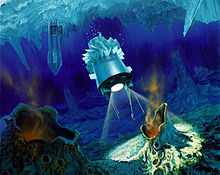Cryobot


A cryobot or Philberth-probe is a robot that can penetrate water ice. A cryobot uses heat to melt the ice, and gravity to sink downward. The difference between the cryobot and a drill is that the cryobot uses less power than a drill and doesn't pollute the environment.
Features and technology
The cryobot is a surface-controlled instrumented vehicle that can penetrate polar ice sheets down to 3,600 metres (11,800 ft) by melting. It can be used to measure temperature, stress, ice movement, and seismic, acoustic and dielectric properties. It can also be used for other investigations with remote instrumentation. The probe consists of a hot point for melt penetration, instrumentation for control and measurement functions, two supply conductor coils to link the probe with the surface for transmission of power and measurement signals, and a reservoir section. The probe is filled with a dielectric fluid.
History
The cryobot was invented by German physicist Karl Philberth, who first demonstrated it in the 1960s as part of the International Glaciological Greenland Expedition (EGIG), achieving drilling depths in excess of 1,000 metres (3,300 ft). In 1973 British scientists in Antarctica performed airborne ice-penetrating radar survey and detected a possible lake.[1] In 1991, the European remote sensing satellite ERS-1 confirmed the 1973 discovery of a large lake below four kilometers of ice, now named Lake Vostok.[2] The lake, which is the fifth largest freshwater lake in the world, is thought to be uncontaminated. NASA was planning to use a cryobot to explore the lake,[3][4] but ultimately Russian scientists ended up using a drill to reach it, which they did on February 5, 2012.[5] The lake’s water, which may have been untouched for 15[6] to 25 million years,[7] is now undergoing analysis to test for the presence of bacteria.
In 2011, NASA awarded Stone Aerospace $4 million to fund the second phase of project VALKYRIE. This project aims to create an autonomous cryobot capable of melting through vast amounts of ice.[8] The probe’s power source differs from many other designs in that it doesn’t rely on nuclear power to generate heat, but rather the power of a high energy laser fed to it through a fiber optic cable. This is beneficial because of the fact that nuclear probes are not allowed for testing in Antarctica as a result of the Antarctic Treaty.[9] Phase 2 of project VALKYRIE will consist of testing a scaled-down version of the cryobot in Matanuska Glacier, Alaska in June 2013 and later Greenland in 2014. The probe will reach a depth of 10 to 50 meters in the first two tests in Alaska and then 200 meters in Greenland. Following the success of these three missions, phase 3 of the project is then planned begin in Antarctica. This phase will use a full-scale version of the cryobot which will melt its way to a subglacial lake, collect samples, and then resurface.[8] This phase of the project will be viewed as a precursor to possible future missions to the icy moons of Europa, a moon of Jupiter, and Enceladus, a moon of Saturn, to explore the liquid water oceans thought to be present below their ice, which may harbor extraterrestrial life.[10][11] [12]
See also
- Autonomous Underwater Vehicle
- DEPTHX
- IceMole
- Radioisotope thermoelectric generator
References
- ↑ Oswald, G. K. A.; Robin, G. de Q. (1973). "Lakes beneath the Antarctic Ice Sheet". Nature 245 (5423): 251–254. doi:10.1038/245251a0.
- ↑ "Ice Station Vostok". Wired. Retrieved 2011-01-31.
|first1=missing|last1=in Authors list (help) - ↑ Susan Reichley. "2002 News Releases - Ice Explorer Conceived for Other World Gets Arctic Test". nasa.gov.
- ↑ Robot to Explore Buried Ice Lake
- ↑ Kaufman, Marc (February 7, 2012). "Health, Science & Environment". The Washington Post.
- ↑ "Lake Vostok drilling in Antarctic 'running out of time'". BBC News. January 28, 2011.
- ↑ "Michael Studinger's Homepage on Subglacial Lakes and Lake Vostok". columbia.edu.
- ↑ 8.0 8.1 "Stone Aerospace • Smart Tools, Systems, and Vehicles for Exploring and Commercializing the Frontier". stoneaerospace.com.
- ↑ "Cryobots Could Drill Into Icy Moons With Remote Fiber-Optic Laser Power". Wired. April 19, 2012.
- ↑ http://www.lpi.usra.edu/meetings/lpsc2004/pdf/2041.pdf#search=%22philberth%20deepest%20ice%20drilling%22
- ↑ "searching for ice". ictp.trieste.it.
- ↑ Time. March 23, 2012 http://www.time.com/time/health/article/0,8599,2109837,00.html. Missing or empty
|title=(help)